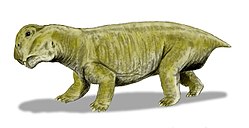| Kitchinganomodon Temporal range: Late Permian | |
|---|---|
| Scientific classification | |
| Kingdom: | Animalia |
| Phylum: | Chordata |
| Clade: | Synapsida |
| Clade: | Therapsida |
| Clade: | † Anomodontia |
| Clade: | † Dicynodontia |
| Family: | † Rhachiocephalidae |
| Genus: | † Kitchinganomodon Maisch, 2002 |
| Type species | |
| †K. crasus (Broom) Maisch, 2002 | |
Kitchinganomodon is a genus of dicynodont from Late Permian (Wuchiapingian) of South Africa. [1]





